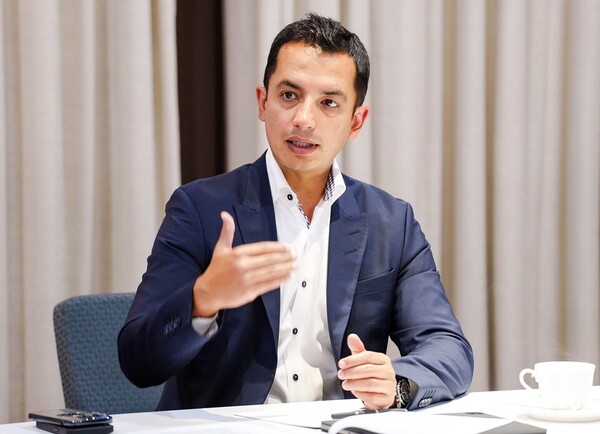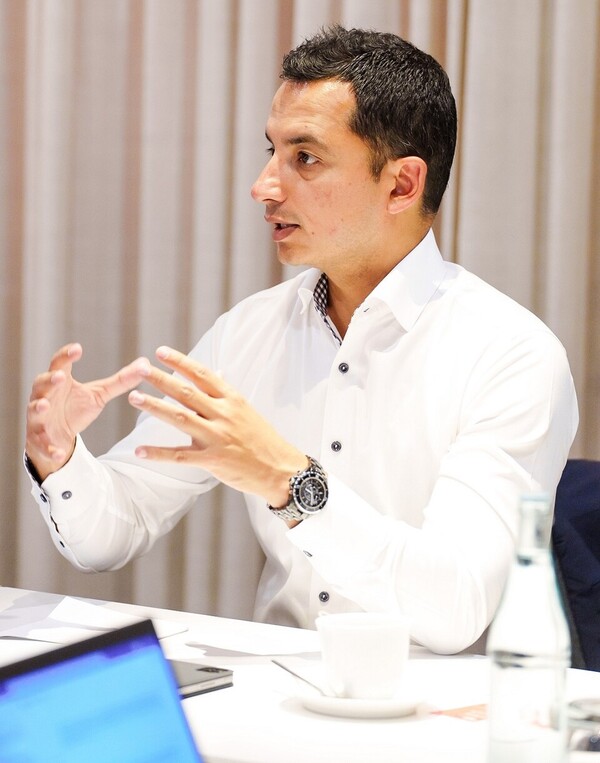SINGAPORE -- The International Association for the Study of Lung Cancer 2023 World Congress of Lung Cancer (IASLC 2023 WCLC), held Sept. 9-12 in Singapore, featured many milestone studies in treating lung cancer.
AstraZeneca showed a particularly remarkable performance.
Its Tagrisso (osimertinib), a third-generation epidermal growth factor receptor (EGFR) tyrosine kinase inhibitor (TKI) that has already become a global standard, was selected as a featured plenary session for the FLAURA2 study, breaking new ground in the first-line treatment of stage 4 lung cancer and attracting the attention of lung cancer experts worldwide.
AstraZeneca also featured more than 40 presentations on its pipeline, including Tagrisso, the immuno-oncology drug Imfinzi (durvalumab), and next-generation antibody-drug conjugates (ADCs).
In Singapore, Korea Biomedical Review sat down with Sunil Verma, Senior Vice President, Global Head of Oncology, Medical, AstraZeneca, to learn more about the company's vision for lung cancer and its efforts to realize it.

Question: AstraZeneca presented lots of data, making a strong presence in lung cancer, at this meeting.
Answer: AstraZeneca could share many of its achievements at WCLC 2023, presenting more than 40 abstracts. And we need to go a few decades back to provide some context.
AstraZeneca developed the first EGFR TKI, Iressa (gefitinib), in the early 2000s. It allowed us to understand the importance of the EGFR mutation itself. The IPASS study, published in 2009, demonstrated that Iressa was a critical drug for patients and paved the way for AstraZeneca's significant milestone in targeted therapies. A few years later, we developed a new agent called Tagrisso, a third-generation EGFR TKI. Developing an agent that would be even more effective than Iressa, overcome resistance, and be well-tolerated by patients was critical. With the publication of studies in 2018 and 2019, we could bring Tagrisso to market, one step more advanced than Iressa.
Through this journey, AstraZeneca could feel the confidence and responsibility to develop innovative treatments in lung cancer based on science and research and to play a leadership role in treating lung cancer. Today, more than 5,000 lung cancer patients worldwide are participating in AstraZeneca's lung cancer clinical studies (based on studies started in 2021 and beyond), including nearly 15 global phase 3 trials. We will continue to build on our heritage of advances for lung cancer patients worldwide and continue to lead advances in lung cancer treatment.
Q: At the meeting, AstraZeneca presented its vision to bring cancer drugs to more than half of all patients treated for lung cancer worldwide.
A: Our ongoing cancer research strategy has several overarching ambitions. The first is to remove “cancer” from a leading cause of death worldwide. This starts with developing treatments that can improve patient survival and ultimately lead to a cure.
In terms of therapeutic development, our current work can be categorized into four main areas: targeted anticancer drugs like Tagrisso, antibody-drug conjugates (ADCs), immune-oncology, where AstraZeneca is creating the next wave of immunotherapy, and the study on how combinations of these therapies can lead to effective combination therapy strategies.
The second primary strategy is to make these innovative therapies available earlier. This includes working with different healthcare systems to diagnose patients at an earlier stage and developing different diagnostic tools to personalize treatment for patients.
Lung cancer treatment is changing rapidly. Some 60-70 percent of lung cancer patients are diagnosed at an advanced stage, virtually impossible to cure, so there are limitations to treating lung cancer. Diagnosing patients early is critical to move forward with our goals. When you consider the difference between breast cancer, where about 85 percent of patients are diagnosed early, and lung cancer, where only about 30 percent of patients are diagnosed early, it's clear what we need to do.
In the past, when patients were diagnosed with cancer at an early stage, they were treated with surgery first and then adjuvant therapy with cancer medicine. However, it was difficult to objectively determine whether the adjuvant therapy effectively treated the cancer because the cancerous mass had already been removed through surgery. Therefore, we are trying to determine the actual effectiveness of the treatment through a paradigm shift called neoadjuvant therapy, which puts the treatment ahead of surgery. This approach will allow us to quickly see how well a new agent works in patients diagnosed early, and if it doesn't work, we can switch to a different treatment.
This is the new paradigm that AstraZeneca is trying to create by developing innovative treatments that improve survival, scaling them up for earlier use, diagnosing cancer earlier, and delivering personalized, precision medicine. In doing so, we hope to achieve our vision of delivering AstraZeneca's innovative therapies to more than half of all patients treated for lung cancer, and we are already well on our way.
Q: According to the company's vision, patient access is a crucial challenge, which is still limited in various regions, including underdeveloped countries. We are curious about what your company does to address this.
A: It's a crucial point. A cure is good only when it reaches the patient. From a medical affairs perspective, AstraZeneca's efforts to improve patient access can be summarized in two ways.
The first is the inclusion of diverse patients in the company's global clinical trials. We design and engage patients to ensure that our studies represent all patients worldwide and that the benefits of our therapies are ultimately valuable to patients of different ethnicities and geographic regions. Second, through our research and development, we aim to ensure that our therapies lead to a definitive improvement for patients, not a marginal improvement.
In other words, we plan clinical studies to help health authorities and healthcare providers worldwide evaluate what our therapies mean to them. Then, we produce solid results to help ensure that patients worldwide can benefit from our therapies.
Q: We also wonder how you rate Korea rates regarding patient access, considering that Tagrisso's primary care reimbursement has been delayed for quite some time.
A: As a physician who has practiced in Canada, I understand that Canada has a similar insurance system to Korea, and because of this environment, there are a lot of different interests involved in reimbursement decisions. Doctors want the best care for their patients, patients want the best care, and the government is in the position of objectively analyzing the effectiveness of different drugs.
Suppose a treatment leads to a significant therapeutic outcome over an existing drug and demonstrates that outcome. In that case, the healthcare system should work to get that drug to patients quickly. It should be made available if the evidence is clear that it improves survival and provides better patient benefits.
That's why I hope first-line Tagrisso can be covered in Korea. And I know many stakeholders are working together to make that happen. I want to reiterate that having a treatment like Tagrisso that has been proven to be effective has a positive impact on the lives of patients and the healthcare system as a whole in the long run.
Q: You mentioned earlier the importance of early diagnosis of lung cancer. Currently, Korea has a lung cancer screening program for smokers. However, the high share of non-smoker lung cancer patients with EGFR mutations has raised questions about the effectiveness of the screening program.
A: The risk factors of Asian lung cancer patients are different from those of Westerners. One of Asia's best-established lung cancer screening programs is in Taiwan, where studies have shown that family history is a greater risk factor for lung cancer than smoking. As a result, Taiwan now offers lung cancer screening to women over 45 with a smoking history or a family history of the disease.
We need to continue to expand our understanding of who should be screened for lung cancer and what the risk factors are in men and women, including non-smokers, through ongoing and diverse discussions in Asian countries. In Korea, one in four cancer deaths is from lung cancer. We have an excellent national screening program in place. Still, we need to gradually raise awareness through campaigns that you don't have to smoke to develop lung cancer due to other risk factors, such as family history. To this end, AstraZeneca is conducting a study with Korean medical teams to identify risk factors associated with non-small cell lunger cancer (NSCLC) in nonsmokers, with results expected in the first half of next year. We will continue to engage in discussions with stakeholders as meaningful findings emerge.

Q: Tell us about the pipeline you are developing to fulfill your vision.
A: At AstraZeneca, we have Tagrisso as a global standard of care, but we are also concerned about resistance mechanisms. About 30 percent of patients develop drug resistance due to MET mutations after treatment with an EGFR TKI, so we know that treatments that target MET are an essential option for these patients, and we are trying different approaches with a MET-targeted therapy called savolitinib. In addition, it is essential to use broadly inclusive agents in patients with distinct resistance mechanisms, regardless of MET variants. ADCs are emerging as an essential approach.
Furthermore, in immunotherapy, the company focuses on developing bispecific antibodies. Bispecific antibodies are agents with two arms, one recognizing cancer cells and the other mediating the immune response. Currently, AstraZeneca has a portfolio of three bispecific antibodies: one against PD-1 and CTLA-4, the other against PD1 and TIGIT, and the third against PD1 and TIM-3 (a factor known to be involved in immuno-oncology drug resistance).
Finally, AstraZeneca is doing a lot of research on ADCs to deliver even better therapeutic outcomes to patients through ADC and immuno-oncology combinations, focusing on that ADCs play a crucial role in killing cancer cells and can enhance the response of immuno-oncology drugs.
Q: What does AstraZeneca want from Korea?
A: Korea is a critical partner for AstraZeneca. As of last year, Korea was one of the "top three" countries for all of AstraZeneca's oncology clinical trials, after the U.S. and China, and this year, it has become the "top two" country after the U.S. Korea is also the second-largest country in terms of the number of patients participating in oncology clinical trials, making it a vital part of AstraZeneca's oncology research and development. The quality of patient care and clinical research conducted by Korean healthcare providers is a model for the rest of the world. That's why AstraZeneca continues to have so many partnerships in Korea, and we want to continue to build on those relationships.
Related articles
- Global experts suggest 5 directives for effective tobacco harm reduction, next-gen products
- 'E-cigarettes could have helped type 2 smokers quit'
- AstraZeneca Korea appoints Chon Se-whan as Country President
- AstraZeneca to pull anti-diabetes blockbuster Forxiga from Korea amid floods of generics
- AZ says Tagrisso effective in unresectable stage-3 EGFRm NSCLC
- Biliary tract cancer patients can now use Imfinzi at their own expense

